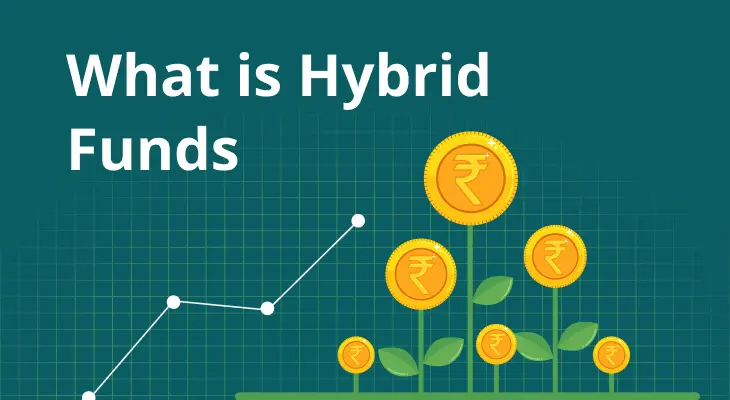Hybrid funds are investment vehicles that blend both equity and debt investments to achieve the scheme’s investment objective. These funds offer a combination of both asset classes tailored to meet the needs of various types of investors. Understand what is hybrid fund?
The key features of a hybrid fund
- a) Diverse Portfolio: A hybrid fund comprises a diverse mix of assets, including equities, debt, and other securities. This allows investors to access multiple asset classes through a single fund.
- b) Balanced Approach: Hybrid funds maintain a balanced portfolio to leverage the strengths of different asset groups. They aim to deliver attractive returns with lower risk levels, catering to both short-term and long-term financial goals. Equities offer growth potential, while debt securities provide stability during market fluctuations.
- c) Variable Investment Combinations: Different types of hybrid funds feature varying equity-debt combinations tailored to meet the financial needs and risk preferences of different investors. These combinations range from conservative to moderate to aggressive, accommodating a wide range of risk tolerances.
- d) Long-Term Performance: Hybrid funds are well-suited for investors with a long-term investment horizon. They typically perform well over the long term, making them suitable for investors willing to hold their investments for at least three to five years.
Types of Hybrid Funds
Hybrid mutual funds encompass various types based on their asset allocation between equity and debt. Here are the classifications:
Equity-Oriented Hybrid Funds: These funds invest a minimum of 65% of their assets in equity and equity-related instruments across different market segments and sectors. The remaining 35% is allocated to debt securities and money market instruments.
Debt-Oriented Hybrid Funds: These funds focus on fixed-income securities like bonds and government securities. At least 60% of their assets are invested in debt instruments. Around 40% is invested in equity, and some funds may allocate a small portion to liquid schemes.
Balanced Hybrid Funds: Investing at least 65% in equity and the rest in debt securities and cash, these funds are treated as equity funds for taxation purposes. They offer tax exemptions on long-term capital gains up to Rs. 1 lakh, making them attractive for equity investors seeking to mitigate volatility with fixed income components.
Monthly Income Plans (MIPs): Primarily investing in fixed-income securities while allocating a small portion to equities, MIPs aim to generate better returns than pure debt schemes. They offer regular income to investors, with the option for income growth within the fund’s corpus.
Arbitrage Funds: These funds capitalize on price differentials between markets by buying low and selling high. During periods of limited arbitrage opportunities, they predominantly invest in debt securities and cash. Considered as safe as debt funds, arbitrage funds’ long-term capital gains are taxed similarly to equity funds.
How does Hybrid funds work?
A hybrid mutual fund operates by striving to achieve a balanced portfolio that provides investors with regular income and long-term capital appreciation.
The fund manager’s role is pivotal as they construct the portfolio in alignment with the scheme’s investment objective. They allocate funds across equity and debt instruments in different proportions based on market conditions and the fund’s strategy. Additionally, the fund manager actively monitors market movements and may adjust the portfolio by buying or selling assets to capitalize on favorable market conditions.
Overall, the hybrid mutual fund aims to optimize returns by blending equity and debt investments while managing risk to meet the needs of investors seeking both income and growth opportunities.
Reasons to invest in Hybrid funds
Investing in a hybrid mutual fund offers several benefits that make it an attractive option:
Balanced Risk: Hybrid funds strike a balance between risk and return, making them less risky than pure equity funds but potentially offering better returns than debt funds. This makes them appealing to investors seeking a moderate level of risk in their investments.
Stability with Growth Potential: The combination of equity and debt components in hybrid funds provides stability from the debt portion while offering growth potential from the equity portion. This balance helps investors navigate market volatility more comfortably.
Suitable for Low-Risk Investors: Hybrid funds are favoured by investors with a low-risk tolerance who seek better returns than what pure debt funds offer. The presence of both equity and debt elements provides a level of security while still offering growth opportunities.
Entry Point to Equity Markets: For new investors hesitant to enter the equity markets directly, hybrid funds serve as a gateway. The inclusion of a debt component offers stability, allowing investors to ease into equity investments gradually.
Diversification: By investing in a hybrid fund, investors gain exposure to both equity and debt markets within a single investment vehicle. This diversification helps spread risk across different asset classes and can enhance overall portfolio stability.
Overall, investing in a hybrid mutual fund provides investors with a well-rounded approach to managing risk while seeking growth opportunities in the financial markets.




